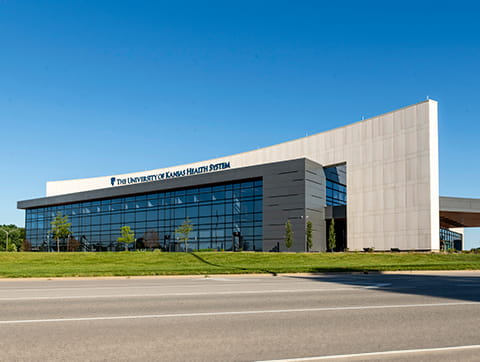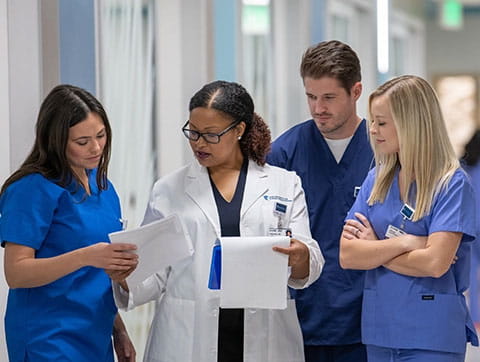Left Atrial Appendage Closure Devices
Some people with heart disease may be at a higher risk for stroke because they cannot be on blood thinners. Many times, especially in people with atrial fibrillation, stroke occurs because of clots that form in the left atrial appendage (LAA) – a small pouch that connects and empties into the top chamber of the heart (left atrium). Procedures to seal off the LAA can help reduce the risk of stroke and eliminate the need for blood thinners.
The University of Kansas Health System offers a variety of devices and surgical techniques for LAA closure. Our heart care specialists often participate in clinical trials to test the safety and effectiveness of LAA closure devices and procedures – making the technology available to patients before anyone else in the region.
What are left atrial appendage closure devices?
People with heart conditions like atrial fibrillation are at greater risk of having a stroke. Because of their heart condition, the typical approach to stroke risk reduction through the long-term use of blood thinners may not be recommended or even possible. Left atrial appendage closure devices offer a different way to limit stroke risk for these individuals.
We offer a variety of appointment types. Learn more or call 913-588-1227 to schedule now.
Who can have left atrial appendage closure devices?
If you have been diagnosed with atrial fibrillation and are unable to tolerate blood thinners, or if you need your LAA closed due to other problems, your care team might recommend an LAA closure device. You will discuss your options for treatment as well as the benefits and risks of each procedure.
How do left atrial appendage closure devices work?
LAA closure devices work by sealing off the left atrial appendage in the heart. This prevents blood clots from escaping into the arteries.
Our health system offers the latest options for left atrial appendage closure devices for people in the Kansas City region and beyond.

Your guide to heart procedures
Benefits and risks of left atrial appendage closure devices
The use of left atrial appendage closure devices allows for stroke risk reduction in those people with heart disease who cannot take blood thinners. People who have a stroke are twice as likely to have a second stroke within the first 5 years after an initial stroke. Proper risk management is essential to limiting the chance of another stroke.
As with any surgery, there are risks associated with left atrial appendage closure devices. Your doctor will only recommend an LAA if they feel it’s the best treatment option for you.
What happens when getting a left atrial appendage closure device?
Once you and your heart team decide that LAA closure is the right stroke-prevention strategy for you, you may need to take certain preparations. This could include tests or diet or medication restrictions. Usually, you will be asked not to eat or drink anything after midnight the night before your surgery.
If you are having a minimally invasive procedure, you will likely be able to return home the same day. Please arrange for a friend or family member to drive you to and from the hospital, as you will be given pain medication and will be unable to drive.
You will likely experience some discomfort following your procedure. This can be controlled with pain medication. Bruising, soreness and inflammation are also common around the area where the catheter was inserted. However, contact your care team if you experience:
- Fainting or dizziness
- Fever that doesn't subside
- Numbness, bleeding, swelling, severe pain, coldness or redness at the site of catheter insertion
- Shortness of breath
Chest pain or discomfort following your procedure should be treated as a medical emergency. If this happens, call 911.
You will be asked to avoid strenuous activity for the first 3 days. Afterward, light walking may be recommended. Most people can resume their daily routine (including exercise) within a few weeks. Ask your doctor about when you can return to work and other normal activities.
Why choose us for left atrial appendage closure devices
- Our heart surgeons work with other specialists as a team. Physicians and professionals from all areas collaborate and coordinate each person's care for the best possible outcome.
- Our outcomes are comparable with the very best programs in the United States.
- Our surgeons are at the forefront of innovation. They have specialized expertise in minimally invasive heart procedure and participate in several unique clinical trials.
- Our surgeons are often the first in the Kansas City region to offer new, innovative technology for LAA closure.
- We are one of the few hospitals in the area offering nonsurgical closures for PFO (patent foramen ovale) and ASD (atrial septal defect).

Unmatched care, year after year
We put patients first and it shows. Our program ranked No. 33 among the nation’s best in U.S. News & World Report’s Best Hospitals 2025-26. Rankings are based on measurable achievements in quality, safety, nursing excellence and more.




